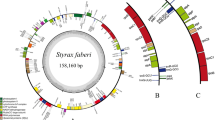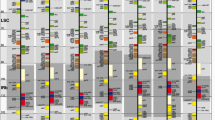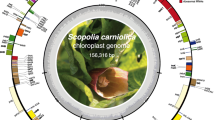Abstract
Malpighiales are one of the most diverse orders of angiosperms. Molecular phylogenetic studies based on combined sequences of coding genes allowed to identify major lineages but hitherto were unable to resolve relationships among most families. Spacers and introns of the chloroplast genome have recently been shown to provide strong signal for inferring relationships among major angiosperm lineages and within difficult clades. In this study, we employed sequence data of the petD group II intron and the petB-petD spacer for a set of 64 Malpighiales taxa, representing all major lineages. Celastrales and Oxalidales served as outgroups. Sequence alignment was straightforward due to frequent microstructural changes with easily recognizable motifs (e.g., simple sequence repeats), and well defined mutational hotspots. The secondary structure of the complete petD intron was calculated for Idesia polycarpa as an example. Domains I and IV are the most length variable parts of the intron. They contain terminal A/T-rich stem-loop elements that are suggested to elongate independently in different lineages with a slippage mechanism earlier reported from the P8 stem-loop of the trnL intron. Parsimony and Bayesian analyses of the petD dataset yielded trees largely congruent with results from earlier multigene studies but statistical support of nodes was generally higher. For the first time a deep node of the Malpighiales backbone, a clade comprising Achariaceae, Violaceae, Malesherbiaceae, Turneraceae, Passifloraceae, and a Lacistemataceae–Salicaceae lineage received significant statistical support (83% JK, 1.00 PP) from plastid DNA sequences.













Similar content being viewed by others
References
APG (1998) An ordinal classification for the families of flowering plants. Ann Missouri Bot Gard 85:531–553
APG (2003) An update of the angiosperm phylogeny group classification for the orders and families of flowering plants: APG II. Bot J Linn Soc 141:339–436
Barkman TJ, Lim S-H, Nais J (2004) Mitochondrial DNA sequences reveal the photosynthetic relatives of Rafflesia, the world’s largest flower. Proc Natl Acad Sci USA 101:787–792
Borsch T, Hilu KW, Quandt D, Wilde V, Neinhuis C, Barthlott W (2003) Noncoding plastid trnT-trnF sequences reveal a well resolved phylogeny of basal angiosperms. J Evol Biol 16:558–576
Borsch T, Hilu KW, Wiersema JH, Lohne C, Barthlott W, Wilde V (2007) Phylogeny of Nymphaea (Nymphaeaceae): evidence from substitutions and microstructural changes in the chloroplast trnT-trnF region. Int J Pl Sci 168:639–671
Borsch T, Löhne C, Müller K, Hilu KW, Wanke S, Worberg A, Barthlott W, Neinhuis C, Quandt D (2005) Towards understanding basal angiosperm diversification: recent insights using rapidly evolving genomic regions. Nova Acta Leopold NF 92:85–110
Cameron KM, Chase MW, Anderson WR, Hillis HG (2001) Molecular systematics of Malpighiaceae: evidence from plastid rbcL and matK sequences. Amer J Bot 88:1847–1862
Chase MW, Soltis DE, Olmstead RG, Morgan D, Les DH, Mishler BD, Duvall MR, Price RA, Hills HG, Qiu YL, Kron KA, Rettig JH, Conti E, Palmer JD, Manhart JR, Sytsma KJ, Michaels HJ, Kress WJ, Karol KG, Clark WD, Hedrén M, Gaut BS, Jansen RK, Kim KJ, Wimpee CF, Smith JF, Furnier GR, Strauss SH, Xiang QY, Plunkett GM, Soltis PS, Swensen SM, Williams SE, Gadek PA, Quinn CJ, Eguiarte LE, Golenberg E, Learn GH, Graham SW, Barrett SCH, Dayanandan S, Albert VA (1993) Phylogenetics of seed plants—an analysis of nucleotide-sequences from the plastid gene rbcL. Ann Missouri Bot Gard 80:528–580
Chase MW, Zmartzy S, Lledó MD, Wurdack KJ, Swensen SM, Fay MF (2002) When in doubt, put it in Flacourtiaceae: a molecular analysis based on plastid rbcL sequences. Kew Bull 57:141–181
Cronquist A (1981) An integrated system of clasification of flowering plants. Columbia University Press, New York
Davis C, Wurdack KJ (2004) Host-to-parasite gene transfer in flowering plants: phylogenetic evidence from Malpighiales. Science 305:676–678
Davis CC, Anderson WR, Donoghue MJ (2001) Phylogeny of Malpighiaceae: evidence from chloroplast ndhF and trnL-F nucleotide sequences. Amer J Bot 88:1830–1846
Davis CC, Chase MW (2004) Elatinaceae are sister to Malpighiaceae; Peridiscaceae belong to Saxifragales. Amer J Bot 91:262–273
Davis CC, Latvis M, Nickrent DL, Wurdack KJ, Baum DA (2007) Floral gigantism in Rafflesiaceae. Science 315:1812–1812
Davis CC, Webb CO, Wurdack KJ, Jaramillo CA, Donoghue MJ (2005) Explosive radiation of Malpighiales supports a mid-Cretaceous origin of modern tropical rain forests. Amer Naturalist 165:E36–E65
De Rijk P, Wuyts J, De Wachter R (2003) RnaViz2: an improved representation of RNA secondary structure. Bioinformatics 19:299–300
Fay MF, Swensen SM, Chase MW (1997) Taxonomical affinities of Medusagyne oppositifolia (Medusagynaceae). Kew Bull 52:111–120
Graham SW, Reeves PA, Burns ACE, Olmstead RG (2000) Microstructural changes in noncoding chloroplast DNA: interpretation, evolution, and utility of indels and inversions in basal angiosperm phylogenetic inference. Int J Pl Sci 161:S83–S96
Gustafsson MHG, Bittrich V, Stevens PF (2002) Phylogeny of Clusiaceae based on rbcL sequences. Int J Pl Sci 163:1045–1054
Hausner G, Olsen R, Johnson I, Simone D, Sanders ER, Karol KG, McCourt RM, Zimmerly S (2006) Origin and evolution of the chloroplast trnK (matK) intron: a model for evolution of group II intron RNA structures. Molec Biol Evol 23:380–391
Hilu KW, Borsch T, Müller K, Soltis DE, Soltis PS, Savolainen V, Chase MW, Powell MP, Alice LA, Evans R, Sauquet H, Neinhuis C, Slotta TAB, Rohwer JG, Campbell CS, Chatrou LW (2003) Angiosperm phylogeny based on matK sequence information. Amer J Bot 90:1758–1776
Huelsenbeck JP, Ronquist F (2001) MrBayes: Bayesian inference of phylogenetic trees. Bioinformatics 17:754–755
Kathriarachchi H, Hoffmann P, Samuel R, Wurdack KJ, Chase MW (2005) Molecular phylogenetics of Phyllanthaceae inferred from five genes (plastid atpB, matK, 3 ‘ndhF, rbcL, and nuclear PHYC). Molec Phylogenet Evol 36:112–134
Kelchner SA (2000) The evolution of non-coding chloroplast DNA and its application in plant systematics. Ann Missouri Bot Gard 87:482–498
Kelchner SA (2002) Group II introns as phylogenetic tools: structure, function, and evolutionary constraints. Amer J Bot 89:1651–1669
Kelchner SA, Wendel JF (1996) Hairpins create minute inversions in non-coding regions of chloroplast DNA. Curr Genet 30:259–262
Kita Y, Kato M (2001) Infrafamilial phylogeny of the aquatic angiosperm Podostemaceae inferred from the nucleotide sequences of the matK gene. Pl Biol 3:156–163
Krosnick SE, Harris EM, Freudenstein JV (2006) Patterns of anomalous floral development in the Asian Passiflora (subgenus Decaloba: supersection Disemma). Amer J Bot 93:620–636
Lehmann K, Schmidt U (2003) Group II introns: structure and catalytic versatility of large natural ribozymes. Crit Rev Biochem Mol 38:249–303
Levinson G, Gutman G (1987) Slipped-strand mispairing: a major mechanism for DNA sequence evolution. Molec Biol Evol 4:203–221
Löhne C, Borsch T (2005) Molecular evolution and phylogenetic utility of the petD group II intron: a case study in basal angiosperms. Molec Biol Evol 22:317–332
Löhne C, Borsch T, Wiersema JH (2007) Phylogenetic analysis of Nymphaeales using fast-evolving and noncoding chloroplast markers. Bot J Linn Soc 154:141–163
Mathews DH, Disney MD, Childs JL, Schroeder SJ, Zuker M, Turner DH (2004) Incorporating chemical modification constraints into a dynamic programming algorithm for prediction of RNA secondary structure. Proc Natl Acad Sci USA 101:7287–7292
Mathews DH, Schroeder SJ, Turner DH, Zuker M (2006) Predicting RNA secondary structure. In: Gesteland RF, Cech TR, Atkins JF (eds) The RNA World. The nature of modern RNA suggests a prebiotic RNA world. Cold Spring Harbor Laboratory Press, Cold Spring Harbor, pp 631–656
Mathews DH, Zuker M, Turner DH (1996–2006) RNAstructure 4.3
Merino Sutter D, Forster PI, Endress PK (2006) Female flowers and systematic position of Picrodendraceae (Euphorbiaceae s.l., Malpighiales). Pl Syst Evol 261:187–215
Michel F, Dujon B (1983) Conservation of RNA secondary structures in two intron families including mitochondrial-encoded, chloroplast-encoded and nuclear-encoded members. EMBO J 2:33–38
Michel F, Umesono K, Ozeki H (1989) Comparative and functional anatomy of group II catalytic introns—a review. Gene 82:5–30
Moline P, Thiv M, Ameka GK, Ghogue JP, Pfeifer E, Rutishauser R (2007) Comparative morphology and molecular systematics of African Podostemaceae-Podostemoideae, with emphasis on Dicraeanthus and Ledermanniella from Cameroon. Int J Pl Sci 168:159–180
Müller J, Müller K (2004) TREEGRAPH: automated drawing of complex tree figures using an extensible tree description format. Mol Ecol Notes 4:786–788
Müller K (2004) PRAP-computation of Bremer support for large data sets. Molec Phylogenet Evol 31:780–782
Müller K (2005a) The efficiency of different search strategies in estimating parsimony jackknife, bootstrap, and Bremer support. BMC Evol Biol 5:58
Müller K (2005b) SeqState: primer design and sequence statistics for phylogenetic DNA datasets. Appl Bioinformatics 4:65–69
Müller K, Borsch T (2005) Phylogenetics of Utricularia (Lentibulariaceae) and molecular evolution of the trnK intron in a lineage with high substitutional rates. Pl Syst Evol 250:39–67
Müller K, Borsch T, Hilu KW (2006) Phylogenetic utility of rapidly evolving DNA at high taxonomical levels: Contrasting mat, trnT-F, and rbcL in basal angiosperms. Molec Phylogenet Evol 41:99–117
Nandi OI, Chase MW, Endress PK (1998) A combined cladistic analysis of angiosperms using rbcL and non-molecular data sets. Ann Missouri Bot Gard 85:137–212
Posada D, Crandall KA (1998) Modeltest: testing the model of DNA substitution. Bioinformatics 14:817–818
Pyle AM, Fedorova O, Waldsich C (2007) Folding of group II introns: a model system for large, multidomain RNAs? Trends Biochem Sci 32:138–145
Pyle AM, Lambowitz AM (2006) Group II introns: ribozymes that splice RNA and invade DNA. In: Gesteland RF, Cech TR, Atkins JF (eds) The RNA world. Cold Spring Harbor Laboratory Press, Cold Spring Harbor, pp 449–505
Qin PZ, Pyle AM (1998) The architectural organization and mechanistic function of group II intron structural elements. Curr Opin Struct Biol 8:301–308
Qiu Y-L, Lee J, Bernasconi-Quadroni F, Soltis DE, Soltis PS, Zanis M (2000) Phylogeny of basal angiosperms: analyses of five genes from three genomes. Int J Pl Sci 161(6 Suppl):3–27
Quandt D, Müller K, Stech M, Frahm J-P, Frey W, Hilu KW, Borsch T (2004) Molecular evolution of the chloroplast trnL-F region in land plants. In: Goffinet B, Hollowell V, Magill R (eds) Molecular systematics of bryophytes, vol 98. Missouri Botanical Garden, St Louis, pp 13–37
Savolainen V, Chase MW, Hoot SB, Morton CM, Soltis DE, Bayer C, Fay MF, De Bruijn AY, Sullivan S, Qiu YL (2000a) Phylogenetics of flowering plants based on combined analysis of plastid atpB and rbcL gene sequences. Syst Biol 49:306–362
Savolainen V, Fay MF, Albach DC, Backlund A, Van der Bank M, Cameron KM, Johnson LA, Lledó MD, Pintaud J-C, Powell M, Sheaham MC, Soltis DE, Soltis PS, Weston P, Whitten WM, Wurdack KJ, Chase MW (2000b) Phylogeny of the eudicots: a nearly complete familial analysis based on rbcL gene sequences. Kew Bull 55:257–309
Schneider JV, Swenson U, Ramuel R, Stuessy T, Zizka G (2006) Phylogenetics of Quiinaceae (Malpighiales): evidence from trnL-trnF sequence data and morphology. Pl Syst Evol 257:189–203
Schwarzbach AE, Ricklefs RE (2000) Systematic affinities of Rhizophoraceae and Anisophyllaceae, and intergenic relationships within Rhizophoraceae, based on chloroplast DNA, nuclear ribosomal DNA, and morphology. Amer J Bot 87:547–564
Setoguchi H, Kosuge K, Tobe H (1999) Molecular phylogeny of Rhizophoraceae based on rbcL sequences. J Pl Res 112:443–455
Simmons MP, Ochoterena H (2000) Gaps as characters in sequence-based phylogenetic analyses. Syst Biol 49:369–381
Soltis DE, Mort ME, Soltis PS, Hibsch-Jetter C, Zimmer EA, Morgan D (1999) Phylogenetic relationships of the enigmatic angiosperm family Podostemaceae inferred from 185 rDNA and rbcL sequence data. Molec Phylogenet Evol 11:261–272
Soltis DE, Soltis PS, Chase MW, Mort ME, Albach DC, Zanis M, Savolainen V, Hahn WH, Hoot SB, Fay MF, Axtell M, Swensen SM, Prince LM, Kress WJ, Nixon KC, Farris JS (2000) Angiosperm phylogeny inferred from 18S rDNA, rbcL, and atpB sequences. Bot J Linn Soc 133:381–461
Stevens PF (2001 onwards) Angiosperm Phylogeny Website. Version 7, May 2006 http://www.mobot.org/MOBOT/research/APweb/
Swofford DL (1998) PAUP*. Phylogenetic Analysis Using Parsimony (*and other Methods). Sinauer Associates, Sunderland
Takhtajan A (1997) Diversity and classification of flowering plants. Columbia University Press, New York
Tokuoka T, Tobe H (2006) Phylogenetic analyses of Malpighiales using plastid and nuclear DNA sequences, with particular reference to the embryology of Euphorbiaceae s. str. J Pl Res 119:599–616
Toor N, Hausner G, Zimmerly S (2001) Coevolution of group II intron RNA structures with their intron-encoded reverse transcriptases. RNA 7:1142–1152
Worberg A, Quandt D, Barniske A-M, Löhne C, Hilu KW, Borsch T (2007) Phylogeny of basal eudicots: Insights from non-coding and rapidly evolving DNA. Org Divers Evol 7:55–77
Wurdack KJ, Hoffmann P, Chase MW (2005) Molecular phylogenetic analysis of uniovulate Euphorbiaceae (Euphorbiaceae sensu stricto) using plastid rbcL and trnL-F DNA sequences. Amer J Bot 92:1397–1420
Zanis MJ, Soltis DE, Soltis P, Mathews S, Donoghue MJ (2002) The root of the angiosperms revisited. Proc Natl Acad Sci USA 99:6848–6853
Acknowledgments
This study is part of the project “Mutational dynamics of non-coding genomic regions and their potential for reconstructing evolutionary relationships in eudicots” supported by the Deutsche Forschungsgemeinschaft (grants BO1815/2 to T.B. and QU153/2 to D.Q.). The funding of this project is greatly acknowledged. T.B. extends his thanks to the Deutsche Forschungsgemeinschaft for a Heisenberg Scholarship. We appreciate the support of Wilhelm Barthlott (Bonn) and Christoph Neinhuis (Dresden). The most important sources of material were the living plant collections at the Botanical Gardens of Bonn University. Their curator, Wolfram Lobin, and staff, especially Michael Neumann and Bernd Reinken helped wherever needed. This research received support from the SYNTHESYS Project http://www.synthesys.info/ which is financed by European Community Research Infrastructure Action under the FP6 “Structuring the European Research Area” Programme (grant to J.V.S., SE-TAF 794) We are also grateful to a number of other institutions and persons who kindly provided plant material: Françoise Prévost (French Guiana), the directors of the herbaria FR, MO, UPS, Edinburgh Botanical Garden (Scotland, UK) for material of Medusagyne oppositifolia, Bochum University Botanical Garden (Germany) for Dovyalis caffra and Osnabrück University Botanical Garden (Germany) for Calophyllum inophyllum; Rolf Rutishauser, University of Zürich (Switzerland) for material of Podostemaceae; Herbario Nacional de Bolivia, Stephan Beck, for duplicate sets of specimens of Caryocaraceae, Chrysobalanaceae, and Trigoniaceae; the Missouri Botanical Garden silica material collection; Elmar Robbrecht of the National Herbarium of Belgium (BR) for material of Irvingia; Kim Govers, Nees-Institute Bonn helped much with the sequencing on the CEQ8000 and the analysis of the sequences. Peter F. Stevens (Missouri Botanical Garden) provided helpful comments on an earlier version of the manuscript.
Author information
Authors and Affiliations
Corresponding author
Rights and permissions
About this article
Cite this article
Korotkova, N., Schneider, J.V., Quandt, D. et al. Phylogeny of the eudicot order Malpighiales: analysis of a recalcitrant clade with sequences of the petD group II intron. Plant Syst Evol 282, 201–228 (2009). https://doi.org/10.1007/s00606-008-0099-7
Received:
Accepted:
Published:
Issue Date:
DOI: https://doi.org/10.1007/s00606-008-0099-7




